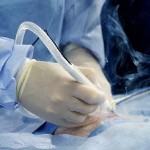 Introduction & Hazards
Introduction & Hazards
Surgical smoke or surgical plume is the name given to the plume that generated from the vaporisation of tissue, primarily from lasers, Electro surgery units (ECU’s), and to a lesser extent ultrasonic devices and high speed drills etc.
It is composed mostly (>90%) of water vapour, with the remainder consisting of a mix of small particulate matter (most of which is <1µm), bio aerosols, cellular material, carbonised tissue, bacteria, viruses, and toxic gases (benzene, toluene, cyanide etc). It is harmful to health, causes eye and upper and lower respiratory tract irritation, and can present an infection risk due to the viable organisms that can be present in the plume. There is some evidence of mutagenicity, and a suspicion of carcinogenicity, though this has not been proven. One study has shown that a gram of vaporised tissue contains a similar amount of mutagenic contaminants as six cigarettes.
Quantification of Exposure
Surgical smoke exposure has been quantified in terms of particles per volume of air, though there is no OELV (Occupational Exposure Limit Value) or agreed safe level to which staff can be exposed to. This means that quantification of exposure and therefore risk is not a simple matter, and the emphasis should be on the provision of effective control rather than trying to establish exposure.
Control Measures
The Primary Control Measure should be the provision and use of LEV (Local Exhaust Ventilation). This usually takes one of three forms:
- On-tip extraction (air extraction systems built in to the surgical instruments). Often disliked by surgeons as can inhibit their dexterity. The effectiveness of these systems is governed primarily by the rate of air flow through them.
- Dedicated, portable smoke evacuator systems. These consist of a pump, and a series of filters including HEPA or ULPA filters for biological agents, and a carbon filter for the toxic chemicals. These appear to be an effective control measure if used properly, though it is vital that the tip is kept within about 50mm of the site of smoke generation, otherwise their effectiveness decreases dramatically. Tubing and usually some of the filters should normally be replaced after each procedure.
- On line wall extraction systems built in to the OR. These generally extract air at a much lower rate than dedicated systems, and should be considered only for procedures that generate low quantities of smoke and in conjunction with good room ventilation.
Secondary Control Measures include the following:
- Good general ventilation in the OR. This usually means a minimum of 20 air changes per hour.
- The use of RPE (Respiratory Protective Equipment). There is currently no consensus on its use, with opinions differing. One suggestion that appears reasonable is that its use be mandatory when there is no LEV system in use, or when working with known disease transmissible cases (e.g. HPV) or with aerosol transmissible diseases (e.g. TB, varicella etc.). Standard surgical masks do not adequately protect against the small particle sizes generated, Surgical FFP2 or FFP3 rated masks are recommended. These should be face-fitted to ensure an adequate fit.
- Administrative Controls – which includes training staff, on the dangers, correct use of control equipment, use of RPE if required, not allowing soft contact lens use when during procedures likely to generate smoke, and staff rotation if possible.
- Health Surveillance – which could include checking for evidence of lung function impairment amongst affected staff. The usual yardstick to decide whether health surveillance is necessary is if you have reason to believe that staff are or have been at risk – as quantitative exposure measurement is not feasible for surgical smoke, this can be difficult to determine, and the best approach would probably be to assume that they are at risk if there are no properly functioning LEV systems in regular use.
In short, you should draft and implement a surgical smoke control plan, which would include clear and simple guidelines for staff on how to deal with the issue effectively. This could include a categorisation of procedures into ‘low smoke’ and ‘high smoke’, and/or ‘disease transmissible’, and a list of the control measures which must be used for each scenario. This could also include a training record, required use and maintenance details for equipment, filters hoses etc. nomination of responsible persons for implementation of the policy, and a record of health surveillance if necessary among other elements.
- Diesel Engine Exhaust Emissions OELV now Active! - 27th February 2023
- We are Hiring…. - 18th May 2016
- Surgical Smoke-A summary of risks and appropriate control measures - 5th May 2016

